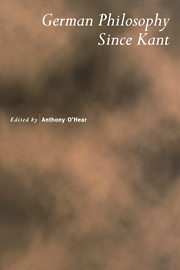Book contents
- Frontmatter
- Contents
- Preface
- Notes on Contributors
- Fichte and Schelling
- Hegel's Critique of Foundationalism in the ‘Doctrine of Essence’
- Schopenhauer's Pessimism
- Karl Marx
- Nietzsche's Virtues: A Personal Inquiry
- Bolzano, Brentano and Meinong: Three Austrian Realists
- Vorsprung durch Logik: The German Analytic Tradition
- German Philosophy of Mathematics from Gauss to Hilbert
- The Revolution of Moore and Russell: A Very British Coup?
- Husserl's Concept of Being: From Phenomenology to Metaphysics
- Frege and the Later Wittgenstein
- Otto Neurath, the Vienna Circle and the Austrian Tradition
- Does the Nothing Noth?
- Reactionary Modernism
- Adorno on Disenchantment: The Scepticism of Enlightened Reason
- Habermas, Science and Modernity
- German Philosophy Today: Between Idealism, Romanticism, and Pragmatism
- The Career of Aesthetics in German Thinking
- Hermeneutic and Analytic Philosophy. Two Complementary Versions of the Linguistic Turn?
- Index of Names
Does the Nothing Noth?
Published online by Cambridge University Press: 29 September 2009
- Frontmatter
- Contents
- Preface
- Notes on Contributors
- Fichte and Schelling
- Hegel's Critique of Foundationalism in the ‘Doctrine of Essence’
- Schopenhauer's Pessimism
- Karl Marx
- Nietzsche's Virtues: A Personal Inquiry
- Bolzano, Brentano and Meinong: Three Austrian Realists
- Vorsprung durch Logik: The German Analytic Tradition
- German Philosophy of Mathematics from Gauss to Hilbert
- The Revolution of Moore and Russell: A Very British Coup?
- Husserl's Concept of Being: From Phenomenology to Metaphysics
- Frege and the Later Wittgenstein
- Otto Neurath, the Vienna Circle and the Austrian Tradition
- Does the Nothing Noth?
- Reactionary Modernism
- Adorno on Disenchantment: The Scepticism of Enlightened Reason
- Habermas, Science and Modernity
- German Philosophy Today: Between Idealism, Romanticism, and Pragmatism
- The Career of Aesthetics in German Thinking
- Hermeneutic and Analytic Philosophy. Two Complementary Versions of the Linguistic Turn?
- Index of Names
Summary
In 1929 Heidegger gave his Freiburg inaugural lecture entitled ‘What is Metaphysics?’ In it he announced: Das Nichts selbst nichtet, ‘The Nothing itself noths (or ‘nihilates’, or ‘nothings’). This soon earned Heidegger fame as a purveyor of metaphysical nonsense. In his 1931 paper, ‘Overcoming of Metaphysics through Logical Analysis of Language’ Rudolf Carnap charged Heidegger with the offences of the whole metaphysical genre. His sentence has the same grammatical form as the sentence ‘The rain rains’ – a sentence which Carnap, or at least his translator, regarded as a ‘meaningful sentence of ordinary language’. But this harmless guise conceals severe logical blemishes. Heidegger treats the indefinite pronoun ‘nothing’ as a noun, as the ‘name or description of an entity’. (When he says ‘The nothing noths’ he surely does not mean ‘There is nothing that noths’ or ‘It is not the case that anything noths’.) He introduces the meaningless word ‘to noth’. He implies, and later affirms, the existence of the nothing, when the ‘existence of this entity would be denied in its very definition’. If all this were not enough, the sentence is meaningless, since it is neither analytic, nor contradictory, nor empirical. It is metaphysics, and metaphysics seriously damages our spiritual health.
- Type
- Chapter
- Information
- German Philosophy since Kant , pp. 271 - 290Publisher: Cambridge University PressPrint publication year: 1999
- 3
- Cited by



